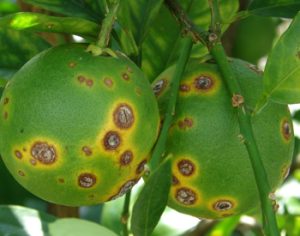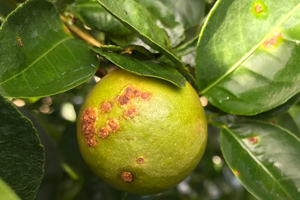
Citrus canker is a bacterial disease, citrus disease caused by the bacterium Xanthomonas citri subsp. citri (synonym X. axonopodis pv. citri)
Infection causes lesions on the leaves, stems, and fruit of citrus trees, including lime, oranges, and grapefruit. While not harmful to humans, canker significantly affects the vitality of citrus trees, causing leaves and fruit to drop prematurely; a fruit infected with canker is safe to eat, but too unsightly to be sold.
The disease, which is believed to have originated in Southeast Asia, is extremely persistent when it becomes established in an area. Citrus groves have been destroyed in attempts to eradicate the disease.
Countries like Brazil and the United States also suffer from canker outbreaks.
A fruit infected with canker is safe to eat, but has reduced marketability as fresh fruit.
HOST
Bacterial canker is a disease of the stems and leaves of Prunus, especially plums and cherries, but also apricots, peaches and ornamental Prunus species.
SYMPTOMS

Citrus canker is mostly a leaf-spotting an fruit rind blemishing disease, but when conditions are highly favorable for infection, infections cause defoliation, shoot dieback, and fruit drop. Citrus canker symptoms include brown spots on leaves, often with an oily or water-soaked appearance. The spots are usually surrounded by a yellow halo, and they can be seen on both the upper and lower sides of the leaf. Similar symptoms can appear on fruit and stems.
FAVOURABLE CONDITIONS
People carrying the infection on their hands, clothing or equipment
Moving infected or exposed plants or plant parts
Wind-driven rain plays a major role in the dispersal of X. axonopodis. The bacteria are said to be readily dispersed by splashed rain and wind and the quantity of X. axonopodis declines after the first event of wind-blown rain dispersal. Apart from that, the bacteria also favor warm weather. The cases of citrus canker are more acute in areas that receive high rainfall and have high mean temperature.
SPREAD AND MOVEMENT
Citrus canker is a highly contagious plant disease and spreads rapidly over short distances. Wind-driven rain and water splash are the primary means of short distance spread within and between trees. Irrigation can increase the risk of disease spread. Contaminated tools and equipment, people and birds can spread citrus canker. Hurricanes and severe weather events of strong winds and rain can spread citrus canker long distances. Citrus canker bacteria may survive for up to 10 months in lesions on living citrus plants.
DISEASE CYCLE
Infection of fruit is most likely to occur during the 90 day period after petal fall during fruit formation. The varied size of lesions on citrus fruit is because of the multiple cycle of infections and can reflect different-aged lesions on the same fruit.
CONTROL
Integrated management practices can reduce citrus canker incidence by
1. Using canker disease-free nursery plants.
2. Pruning and burning infected twigs.
3. Spraying copper-based bactericides.
4. Developing canker-resistant varieties.
[prisna-google-website-translator]





